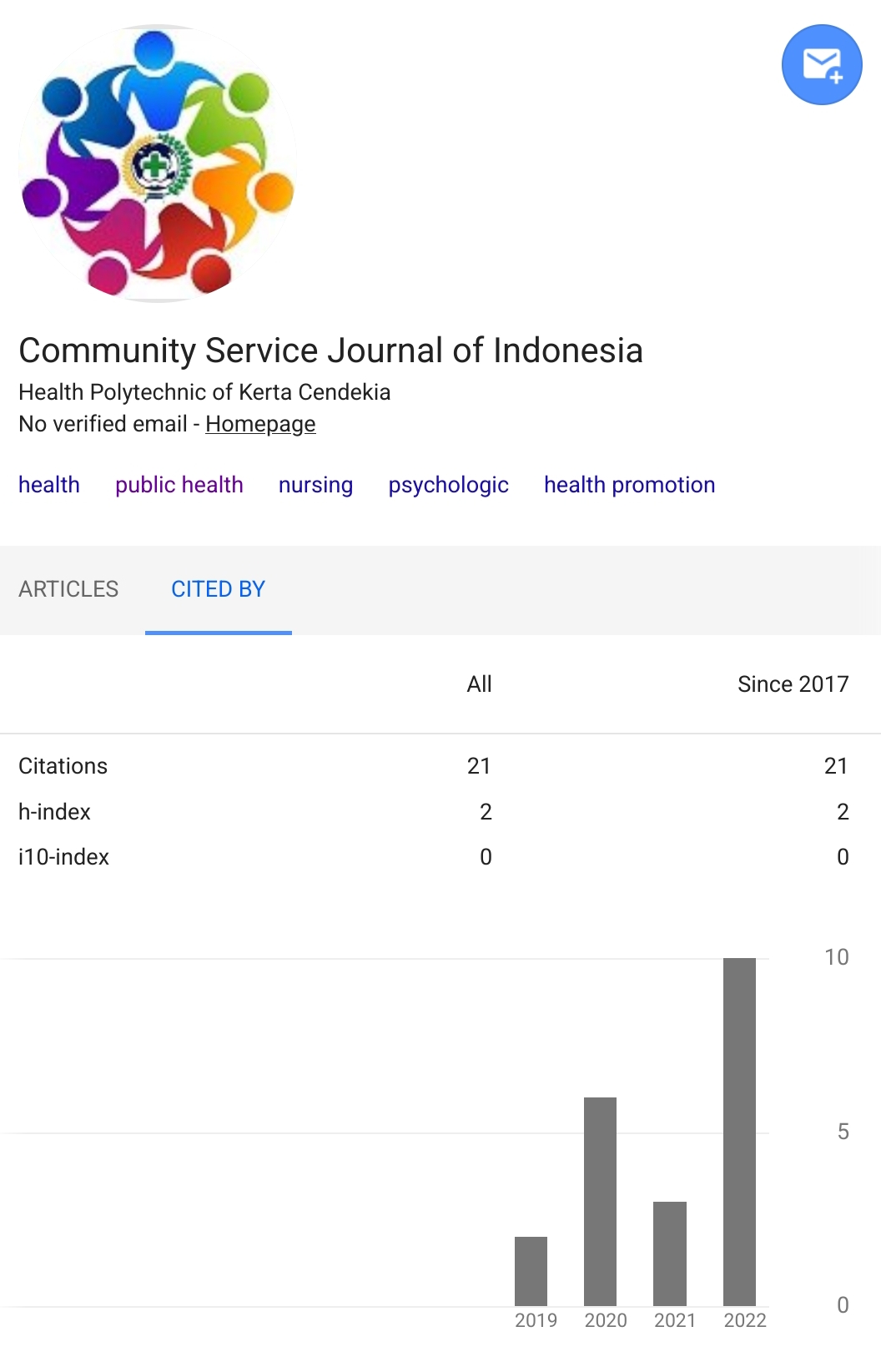EDUCATION SIX STEPS OF HAND WASHING FOR ELEMENTARY SCHOOL STUDENTS
Abstract
The six steps hand washing counseling activity given to grade five students at Rangkah Kidul Sidoarjo Elementary School is a form of community service in the form of presenting material and simulations which are expected to prevent disease in children. Implementation of counseling activities on January 26, 2023 at Rangkah Kidul Sidoarjo Elementary School. Target of this counseling activity is students of class 5A and 5B at Rangkah Kidul Sidoarjo Elementary School. Prior to carrying out extension activities, there is a process of preparing activities for approximately four weeks prior to implementation activities, starting from determining the type of extension to applying for permits to related parties. As a form of evaluation, the activity was attended by 47 grade five students, the participants took part in the activity with great enthusiasm, and the counseling activities ran smoothly.References
Amalia, R. N. (2019). Pemanfaatan Video Mencuci Tangan Dalam Meningkatkan Motivasi Dan Praktik Mencuci tangan Pada Anak Usia Sekolah Dasar. Jurnal Keperawatan, 10(1), 19–24. Retrieved from http://ejournal.akperykyjogja.ac.id/index.php/yky/issue/view/8 DOI: https://doi.org/10.31227/osf.io/z64et
Johan, H., Reni, D. N., & Noorbaya, S. (2018). Pengaruh Penyuluhan Media Audiovisual Video Terhadap Perilaku Cuci Tangan Pakai Sabun Pada Siswa Kelas III di SDN 027 Samarinda. Jurnal Husada Mahakam, 4(6), 352–360. DOI: https://doi.org/10.35963/hmjk.v4i6.138
Kemenkes RI. (2011). Modul Pelatihan Cuci Tangan Pakai Sabun. Jakarta: Kementrian Kesehatan Republik Indonesia.
Kemenkes RI. (2016). Perilaku Hidup Bersih dan Sehat. Jakarta: Kementrian Kesehatan Republik Indonesia.
Kemenkes RI. (2019). Laporan Nasional Riskesdas 2018. Jakarta: Badan Penelitian dan Pengembangan Kesehatan.
Listiadesti, A. U., Noer, S. M., & Maifita, Y. (2020). Efektivitas Media Vidio Terhadap Perilaku Cuci Tangan Pakai Sabun Pada Anak Sekolah: A Literature Review. Jurnal Menara Medika, 3(1), 1–12. https://doi.org/https://doi.org/10.31869/mm.v3i1.2198
Muwakhidah, M., Fatih, F. D., & Primadani, T. (2021). Efekvitas Pendidikan Dengan Media Boklet, Leaflet Dan Poster Terhadap Pengetahuan Tentang Anemia Pada Remaja Putri. The 14 Th University Research Colluqium 2021.
Padila, P., Andri, J., J, H., Andrianto, M. B., & Admaja, R. D. (2020). Pembelajaran Cuci Tangan Tujuh Langkah Melalui Metode Demonstrasi pada Anak Usia Dini. Journal of Telenursing, 2(2), 112–118. https://doi.org/https://doi.org/10.31539/joting.v2i2.1395 DOI: https://doi.org/10.31539/joting.v2i2.1395
Proverawati, A., & Rahmawati, E. (2012). Perilaku hidup bersih dan sehat (PHBS) (1st ed.). Yogyakarta: Nuha Medika.
RI, D. (2010). Pedoman pelaksanaan promosi kesehatan di puskesmas. Jakarta: Departemen Kesehatan RI.
RI, K. (2015). Profil Kesehatan Indonesia tahun 2014. Jakarta: Kemenkes RI.
Silalahi, S. S. (2019). Efektivitas Metode Demonstrasi dan Media Video tentang Pemeriksaan Tanda - Tanda Vital terhadap Kemampuan Keterampilan Klinis Mahasiswa Keperawatan Universitas Sumatera Utara. Universitas Sumatra Utara.
Tietjen, B. (2009). Pencegahan infeksi untuk fasilitas pelayanan kesehatan dengan sumber daya terbatas. Jakarta: Bina Pustaka Sarwono.
Wati, N., & Paridah, P. (2017). Pengaruh Intervensi Penayangan Video terhadap Pengetahuan, Sikap dan Tindakan Tentang Cuci Tangan Pakai Sabun pada Siswa Sdn 10 Kabawo Tahun 2016. Jurnal Ilmiah Mahasiswa Kesehatan Masyarakat Unsiyah, 2(5), 1–11. DOI: https://doi.org/10.20527/jbk.v1i1.660
Copyright (c) 2023 nisa dewanti, Kiki Widyasari

This work is licensed under a Creative Commons Attribution-NonCommercial 4.0 International License.
Authors who publish with Community Service Journal of Indonesia agree to the following terms:
- Authors retain copyright licensed under a Creative Commons Attribution-NonCommercial 4.0 (CC BY-NC 4.0), which allows others to remix, tweak, and build upon the authors' work non-commercially, and although the others' new works must also acknowledge the authors and be non-commercial, they don't have to license their derivative works on the same terms.
- Authors are permitted and encouraged to post their work online (e.g., in institutional repositories or on their website) prior to and during the submission process, as it can lead to productive exchanges, as well as earlier and greater citation of published work (See The Effect of Open Access). Authors can archive pre-print and post-print or publisher's version/PDF.













